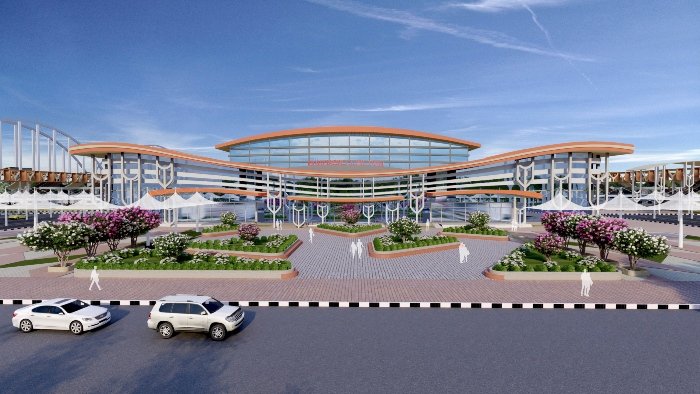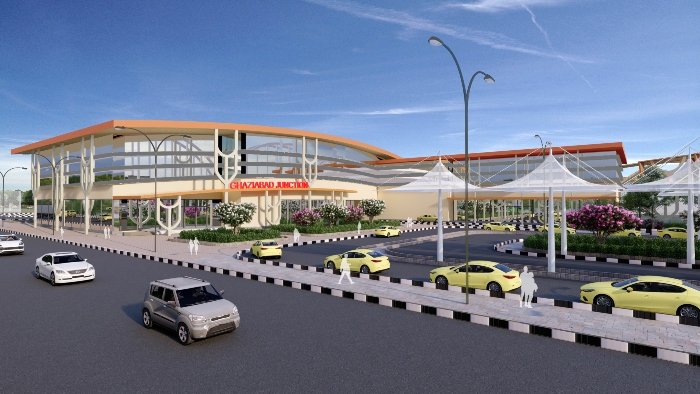Located in the heartland of Uttar Pradesh, Ghaziabad Junction plays a critical role in the Indian Railway system, connecting countless lives across the nation. As the hub of over a hundred long-distance passenger trains, the Ghaziabad Railway Station is on the cusp of significant transformation, blending tradition with modernity.
The Ghaziabad Railway Station, an ambitious project, seeks to transform the city’s public commute and transit system. Spearheaded by the architectural firm Creative Group LLP at a cost of ₹450 crore, the project spans an expansive site area of 170 acres. The objective is to alleviate congestion and minimise station loading through smart design, creating a world-class transit hub with enhanced passenger amenities.
The Creative Vision
Gurpreet Shah, Principal Architect & Urban Designer, Creative Group LLP, rightly sums up the project’s ethos, “To create an efficient building typology, it is important to understand that architecture is not just a piece of art but it follows a design intent where architecture and engineering can comprehensively be thought of.”
Breathing new life into the station, the architects have envisioned a design that strikes a balance between the strong existing architecture and a more fluid, modern aesthetic. Drawing inspiration from the arches and murals found on platforms 3 and 4, they have innovatively incorporated these elements into the modern glass façade, adding a distinct character and preserving the past’s echoes.
Prof. Charanjit Shah, Founder & Principal, emphasises, “India is heading to be a developed nation, needs large improvements in developments of its infrastructure like airports, railways and national highways. This renovation is a step towards fulfilling this vision, signalling a paradigm shift in the perception of railway stations from mere transitional points to integrated spaces offering a variety of amenities and facilities.”
The station will integrate various forms of transport such as trains, buses, shared autos, bikes, and cars to streamline connectivity. Emphasising equal accessibility, the project will also revitalise the station’s surroundings with an emphasis on pedestrian-friendly plazas, concourses, and green spaces, creating a sustainable, accessible, and efficient transit system. With a focus on safety and comfort, the redevelopment promises to foster social cohesion and promote pride in civic infrastructure, shaping Ghaziabad into a city of the future.
Unique Highlights
A comprehensive multi-modal transport hub is in the works, designed to seamlessly integrate various modes of transportation, including the railway station, long-distance buses, metro, BRT (Bus Rapid Transit), IPT (Intermediate Public Transport), cars, and pedestrian pathways. This innovative green and smart infrastructure prioritises accessibility for all, including individuals with disabilities, while also complying with fire safety standards and encouraging non-motorised transport.
To enhance convenience, new entrances will be established on both the West and East sides of the railway station, complemented by a roof plaza exclusively dedicated to train passengers, facilitating separate entry and exit points. Additionally, a modern ISBT (Inter-State Bus Terminal) will be constructed with designated alighting and boarding bays, eliminating the need for passengers to navigate road crossings. Traffic flow will be significantly improved through the creation of elevated circulation roads, positioned 12.5 m above ground level, offering enhanced access to the railway station, ISBT, and commercial areas. This ambitious project also encompasses commercial development opportunities above the railway station, ISBT, and adjacent land parcels, promising a holistic approach to transportation and urban development.
Furthermore, all buildings will feature modern amenities, security arrangements, access controls, and efficient space utilisation. They will be equipped with vertical circulation elements like escalators, lifts, and stairs as per requirements. For outdoor spaces, there will be landscaping, access roads, and parking spaces as per standards. The excavation work for the basement in each building will only begin after ensuring adequate protection on all sides.

The City Side Building
A multi-level structure features a ground floor with 4,218 sq m of space, a first floor spanning 2,733 sq m, a mezzanine floor covering 2,748 sq m, and a spacious basement area measuring 3,225 sq m. Additionally, the building offers the flexibility to accommodate an extra floor and includes a stilt area of 169 sq m. Key features encompass advanced security measures such as access controls, a metal detector system, and a baggage scanner system. The facility also boasts ticket counters, commercial spaces, office rooms, well-appointed modular toilets, comfortable waiting rooms, and convenient lifts and escalators for accessibility. Furthermore, a food court adds to the convenience and amenities available within this versatile structure.
The Vijaynagar Side Building
The building offers a G+2 design with the potential for an additional floor and an accommodating basement. The ground floor boasts a generous expanse of 3,015 sq m, complemented by a mezzanine floor covering 2,800 sq m, while the first floor provides 2,993 sq m of space. Below ground, a basement of 3,000 sq m further extends its footprint. Adding to its versatility, a stilt area of 606 sq. m is integrated into the design.
Air Concourse and FOBs
The air concourse is a substantial space, measuring 72 m in width and encompassing an expansive 8,571 sq m. This area serves as a vital connection between the city side and Vijay Nagar side buildings, with a multifaceted purpose. It caters to passenger needs by offering waiting areas, and retail provisions, facilitating passenger transfers to platforms, and providing an exclusive vantage point for viewing the station’s surroundings.
Additionally, the Foot Over Bridges (FOB) is undergoing significant improvements. Two FOBs are slated for refurbishment and construction, equipped with essential amenities such as lifts, escalators, and stairs for enhanced accessibility. FOB A, after refurbishment, will cover an area of 1,870 sq m, expanding by 20 m on both sides and totalling 810 sq m. Meanwhile, FOB B represents a new construction, boasting an impressive area of 2,260 sq m and a covering area of 2,711 sq m. These developments aim to enhance the overall functionality and convenience of the station.
Staff Quarters
The SNT Hostel is situated on the city side and spans an impressive area of 5,969 sq m. This contemporary facility promises to cater to various accommodation needs.
In addition to this, the staff quarters offer a range of options to suit diverse preferences and requirements:
Type III: Offering a total of 96 units, each featuring a minimum plinth area of 73 sq m, ensuring comfortable living spaces for the staff.
Type IV: Two units with generous dimensions, providing 138 sq m of living space, along with the potential for future floor expansion.
Type V: These quarters are characterised by spaciousness, with each unit boasting a minimum plinth area of 210 sq m, offering ample room for comfortable living arrangements.
Crafting Brilliance
The redeveloped Ghaziabad Junction is designed to shine with glass facades and external structure glazing, emphasising a sense of continuity between its exterior and interior spaces. Within the building, a double-height room creates an expansive core, gathering light and facilitating circulation.
Moreover, the junction is branching out into commercial enterprises, introducing food courts and retail outlets as part of the redevelopment plan, ensuring an immersive, satisfying, and productive experience for travellers.
A distinctive feature of the station’s construction is its innovative use of local materials, paying homage to Ghaziabad’s identity. Red sandstone and Dholpur stone, known for their resistance to acidity, alkalinity, and salinity, are thoughtfully integrated into the design. These elements are complemented by Glass Fibre-Reinforced Concrete (GFRC) panels, strategically placed between glass sections to enhance the station’s aesthetics.

Furthermore, the redevelopment project places considerable emphasis on often-overlooked platform spaces. The design incorporates protective shades, efficient lighting, comfortable seating, and informative digital panels, prioritising passenger comfort and convenience throughout their journey.
Amidst this architectural transformation, the Ghaziabad Junction project encompasses various structures. In line with contemporary trends, steel serves diverse roles in structural frameworks, facades, canopies, and other architectural elements. Its inherent strength and flexibility open the door to creating expansive cantilevers and slender structural features.
Notably, steel aligns seamlessly with sustainability objectives, given its recyclability. A significant proportion of the steel employed in the project originates from recycled sources, and at the end of a building’s lifecycle, its steel components can be recycled. This not only bolsters structural integrity but also minimises waste and resource consumption through off-site fabrication and precision manufacturing techniques.
Moreover, steel construction offers efficiencies in construction timelines, thanks to the ability to prefabricate elements off-site and swiftly assemble them on-site. This approach minimises disruptions, expedites construction, and often leads to cost savings in foundation expenses, courtesy of steel’s impressive strength-to-weight ratio.
Innovative Techniques
The Ghaziabad Junction project reflects the dynamic evolution of steel construction in recent years, embracing innovative techniques and technologies. The usage of 3D modelling and creating a digital representation of both physical and functional characteristics has empowered the stakeholders to visualise the entire structure well before construction commences. It has aided in optimising designs, allocating resources efficiently, and preemptively addressing potential challenges.
The practice of constructing building sections in a controlled factory environment and subsequently transporting and assembling them on-site has allowed the team to expedite construction timelines and elevate the overall quality and efficiency of the project.
The rejuvenation of Ghaziabad Junction manifests India’s growing focus on transforming its transit hubs. It represents a major stride in strengthening the country’s infrastructure, encapsulating the vision of merging heritage with advanced technology and enhancing the journey’s experience from arrival to departure. In this blend of tradition and modernity, the junction is set to become a testament to India’s evolving cityscape.
Fact File
• Client: Indian Railways
• Architect: Creative Group LLP
• Consultant: Creative Group LLP
• Tonnage: Approximately 4,300 MT
• Status: Under Construction





